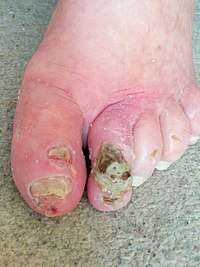Arterial insufficiency ulcer
Arterial insufficiency ulcers (also known as ischemic ulcers, or ischemic wounds) are mostly located on the lateral surface of the ankle or the distal digits.[1] They are commonly caused by peripheral artery disease (PAD).
| Arterial insufficiency ulcer | |
|---|---|
 | |
| A 71-year-old diabetic male smoker with severe peripheral arterial disease presented with a dorsal foot ulceration (2.5 cm X 2.4cm) that had been chronically open for nearly 2 years. |
Characteristics
The ulcer has punched-out appearance. It is intensely painful. It has gray or yellow fibrotic base and undermining skin margins. Pulses are not palpable. Associated skin changes may be observed, such as thin shiny skin and absence of hair. They are most common on distal ends of limbs. A special type of ischemic ulcer developing in duodenum after severe burns is called Curling's ulcer.
Cause
The ulcers are caused by lack of blood flow to the capillary beds of the lower extremities. Most often endothelial dysfunction is causative factor in diabetic microangiopathy and macroangiopathy.[2] In microangiopathy, neuropathy and autoregulation of capillaries leads to poor perfusion of tissues, especially wound base. When pressure is placed on the skin, the skin is damaged and is unable to be repaired due to the lack of blood perfusing the tissue. The wound has a characteristic deep, punched out look, often extending down to the tendons. The wounds are very painful.[3]
Diagnosis
The lesion can be easily identified clinically. Arterial doppler and pulse volume recordings are performed for baseline assessment of blood flow.[4] Radiographs may be necessary to rule out osteomyelitis.
Management

The prevalence of arterial insufficiency ulcers among people with Diabetes is high due to decreased blood flow caused by the thinning of arteries and the lack of sensation due to diabetic neuropathy. Prevention is the first step in avoiding the development of an arterial insufficiency ulcer. These steps could include annual podiatry check ups that include, "assessment of skin, checking of pedal pulses (assessing for blood flow) and assessing physical sensation".[5] The management of arterial insufficiency ulcers depends on the severity of the underlying arterial insufficiency. The affected region can sometimes be revascularized via vascular bypass or angioplasty. If infection is present, appropriate antibiotics are prescribed. When proper blood flow is established, debridement is performed. If the wound is plantar (on walking surface of foot), patient is advised to give rest to foot to avoid enlargement of the ulcer. Proper glycemic control in diabetics is important. Smoking should be avoided to aid wound healing.[6]
Epidemiology
These ulcers are difficult to heal by basic wound care and require advanced therapy, such as hyperbaric oxygen therapy or bioengineered skin substitutes. If not taken care of in time, there are very high chances that these may become infected and eventually may have to be amputated. Individuals with history of previous ulcerations are 36 times more likely to develop another ulcer.[7]
See also
- Peripheral artery disease
- Venous insufficiency ulceration
- List of cutaneous conditions
References
- James, William D.; Berger, Timothy G.; et al. (2006). Andrews' Diseases of the Skin: clinical Dermatology. Saunders Elsevier. ISBN 0-7216-2921-0.
- La Fontaine J, Harkless LB, Davis CE, Allen MA, Shireman PK (2006). "Current concepts in diabetic microvascular dysfunction". 96 (3): 245–52. PMID 16707637. Cite journal requires
|journal=(help) - Hampton S (2006). "An introduction to various types of leg ulcers and their management". Br J Nurs. 15 (11): S9–13. doi:10.12968/bjon.2006.15.Sup2.21235. PMID 16835515.
- Sykes MT, Godsey JB (January 1998). "Vascular evaluation of the problem diabetic foot". 15 (1): 49–83. PMID 9463768. Cite journal requires
|journal=(help) - American Diabetes Association. Standards of medical care in diabetes-2011. Diabetes Care. 2011;34(Suppl. 1):S11–S61
- "American Diabetes Association Guidelines. Preventive foot care in people with diabetes". 23 Suppl 1. January 2000: S55–6. PMID 12017679. Cite journal requires
|journal=(help) - Armstrong DG, Lavery LA, Harkless LB (May 1998). "Validation of a diabetic wound classification system. The contribution of depth, infection, and ischemia to risk of amputation". 21 (5): 855–9. doi:10.2337/diacare.21.5.855. PMID 9589255. Cite journal requires
|journal=(help)